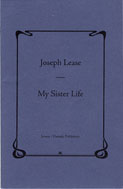 Joseph Lease
Joseph Lease
Jensen / Daniels Publishers ($4)
by Thomas Fink
A poet of lyric grace and specific, evocative images, Joseph Lease engages in trenchant, often startling associative jumps while also offering narrative's edifying vitality. My Sister Life, Lease's third collection, consists of three long sequences, two short poems, and one short prose-poem. If "Life's" "Sister" is "Death," then the title announces the book's main thematic preoccupation. As in his previous book, Human Rights (1998), Lease explores the Holocaust in relation to the situation of contemporary American Jews. "'the Jew with the hole in his voice'" exemplifies the strengths and challenges of Lease's associative method:
First we killed them, then they killed us. The wind is steel wool. Then, first they killed us then we killed green. Sunlight lathers blonde, oiled wood. Light from the hole that keeps unfolding under his stomach. She'll hear or not hear snow walking on the rooftop. She'll go for long walks late at night when the town is sleeping. She'll hear or not hear history walking on the rooftop. Families drowning, dancing in loops, singing words they loved.
Can the prose-poem's first sentence be glossed by a later assertion, "Those to whom evil was done did evil again as ghosts"? Perhaps the Jews annihilated in the Holocaust "slay" the Nazis with moral judgment, but Lease may refer to the tendency for oppressed people to go on to oppress others (and perhaps to the Israeli-Palestinian conflict.) As in "The History of Our Death," a long sequence in the book, the murder of "green" probably alludes to ways in which historical nightmares overwhelm individuals' capacity to enjoy nature's bounty. "Sunlight"—no spiritual illumination—is like cheap soap, and the capacity "to hear" the natural substance of "snow," as well as exigencies of "history" (including "families drowning") is very much in doubt. The prose-poem itself is "dancing in loops" of images and diverse assertions that refuse facile closure.
In the long "Broken World," Lease's examination of death/life focuses on pressures of contemporary U.S. society rather than specifically Jewish experience. The opening stanzas of the first section represent a dying—whether accidental, natural, or suicidal—in images so spare and elegantly tuned that they haunt while withholding determinate narration of a specific man's fall:
faith and rain
brightness fallsblank as glass
brightness fallsuntil he
can't bend
light anymore.
"Blankness" cancels light and the ability to "bend" it to human purposes, and it may even cancel a sustaining "faith." A lamentation cataloguing negations measures the absoluteness of loss: "Won't be stronger. Won't be water. / Won't be dancing or floating berries. / Won't be a year. Won't be a song. / Won't be taller." In an ambiguity produced by a felicitous placement of lines, the living poet registers the destructive effect of death on his psyche and his determination to combat those who would dishonor the deceased's memory: "You are with me / and I shatter // everyone who / hates you."
In contrast, the single prose paragraph of Section 2 presents a free-wheeling social critique: "To be a man, to be, to try. I hate the word man. I'm not crazy about the word husband or the word father either. To try. To heal the night or day. I'm busy selling fighters and bombers. The NASDAQ moves in my face." Queasiness about particular language involves despair about a masculinist culture in which the hawking of destruction and obsession with material acquisition displace efforts "to heal" and in which the denigration of women is ubiquitous: "Two blocks from campus, a boy, maybe ten or eleven, yelled at a Junior High School girl: 'Ho-bag, incest baby, spread your legs.'" Similarly, the record of economic colonization and postcolonial exploitation in U.S. foreign policy has proved more than embarrassing: "America equals ghost. The wrong side of history." To re-establish faith in a camaraderie that death cannot undo and to honor the intensity of death's mark—to move past paralyzing disillusionment with U.S. society's violent banalities—Lease returns in the third and last section to reconfigurations of the potent lyric motifs of the first: "Arrows on water; // you are with me— / rain on snow—"
In My Sister Life, "histories of death" that haunt Joseph Lease spur him into haunting, innovative song.
Click here to buy this book at Amazon.com
Rain Taxi Online Edition, Spring 2002 | © Rain Taxi, Inc. 2002
